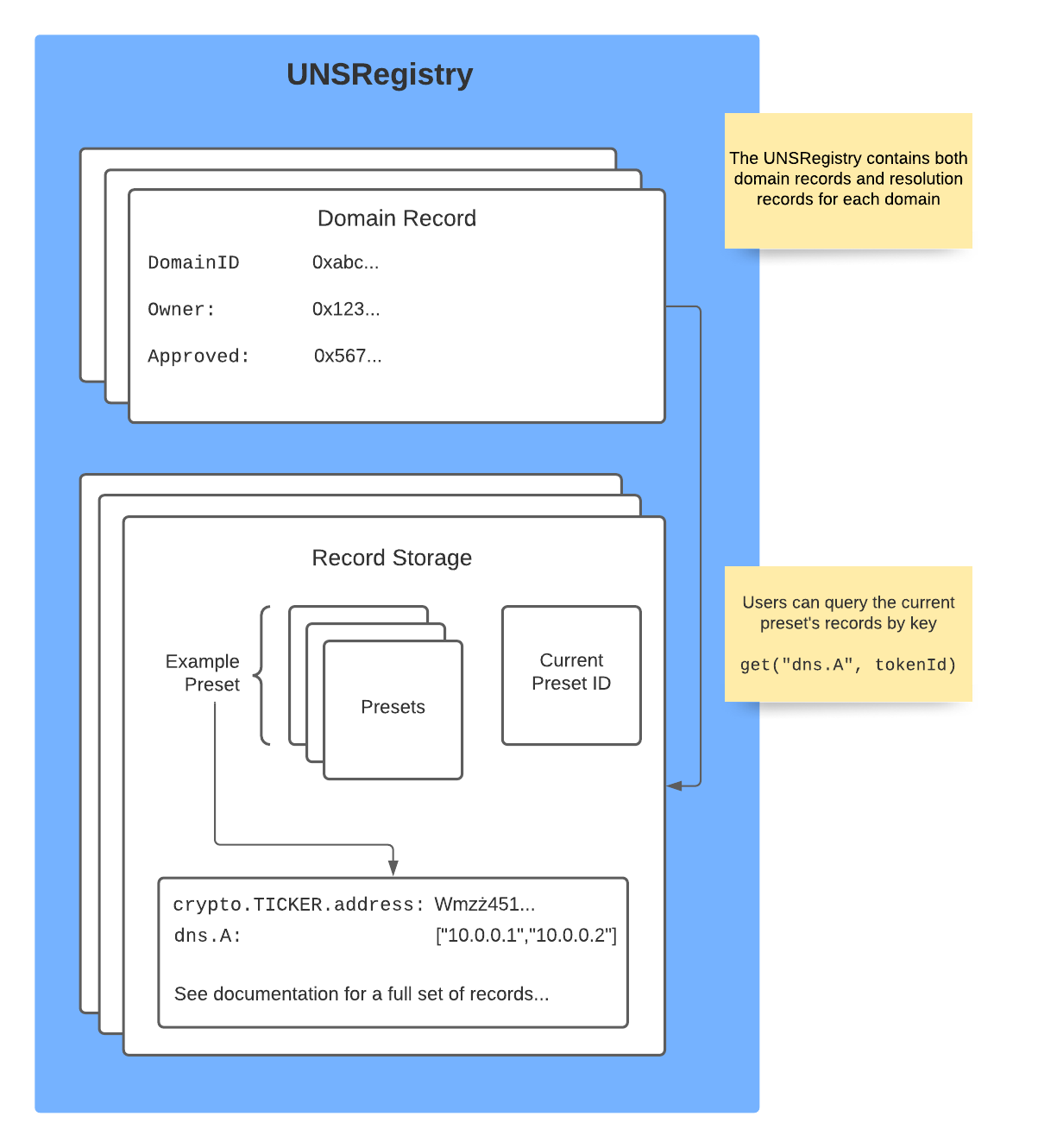Manage Domain Records Overview
This page describes the record architectures for UNS and CNS, record types, and administrative patterns for managing domain records.
Domain Record Architectures
UNS
For UNS, domain records are managed via RecordStorage.

CNS
For CNS, domain records are managed via the default Resolver or through a custom resolver with defined management permissions.

Domain Record Types
Records on the top-level are stored in a simple key-value pair mapping string to string. CNS, ZNS, and UNS doesn't prohibit a member from assigning any record to any value. However, there is a list of standard records that have a defined standard interpretation by clients. A full list of standardized records can be found in the Records reference.
Standard record keys are split by namespaces with a . used as a separator.
The main namespaces are:
-
crypto.*— Records related to crypto payments -
dns.*— DNS records -
dweb.*— Records related to distributed content network protocols -
browser.*— Hint records for web browsers
Crypto Payment Records
One essential feature of Web3 domains is the ability to specify a human-readable name instead of a destination address for your crypto payment. Cryptocurrency wallets that use this feature will resolve a domain to an underlying crypto address in the same way a browser resolves a domain to IP address.
All crypto addresses are stored within the crypto.* namespace. Each currency address is stored as a crypto.<TICKER>.address record.
Example: Bitcoin address is stored in
crypto.BTC.address.
Addresses are stored in plain text format according to an address space standard established by each currency. The currency's namespace can contain additional currency-specific attributes to facilitate payment delivery.
Example: Ripple destination tag.
However, key names for those attributes are not yet standardized. Please contact Unstoppable Domains support if you need such attributes to be added to the standard.
Some tickers of very popular cryptocurrencies are not yet standardized. Example: LINK for Chainlink. A standardized list of tickers can be found in SLIP-0044. However, a more extended list of conventional tickers is available at cripti/cryptocurrencies.
Example crypto records setup:
| Key | Value |
|---|---|
crypto.ETH.address |
0xD1E5b0FF1287aA9f9A268759062E4Ab08b9Dacbe |
crypto.BTC.address |
bc1qkd4um2nn2uyzmsch5y86wsa2pfh8xl445lg9nv |
crypto.ZIL.address |
zil1yu5u4hegy9v3xgluweg4en54zm8f8auwxu0xxc |
crypto.USDT.version.ERC20.address |
0x8aaD44321A86b170879d7A244c1e8d360c99DdA8 |
crypto.USDT.version.TRON.address |
THG9jVSMfKEbg4vYTYWjmLRyga3CKZdDsk |
USDT is present on multiple chains and key format is slightly different. More details can be found in the Records Reference documentation.
Domain Record Administrative Patterns
Ownership Styles
CNS Resolver and UNS RecordStorage allows members to manage all domain records for any address given a permission over domain with the ERC721 "Transfer Mechanism". This enables a subset of addresses to manage the domain on your behalf. By default, we give the permission to do this to every address that can already transfer ownership of the domain. These include:
- Owner address of a domain
- Approved address for a domain
- Owner's operator addresses
This allows members to still retain primary ownership of their domain. These smart contracts can be programmed in such a way that they only change specified records. An Oracle Integration works in this way. For example:
- Members grant operator access to all of their domains to the Oracle Contract.
- Oracle detects an event off chain.
- The Oracle sets a record inside the resolver contract.
See ERC-721 on how those permissions can be granted and revoked. Any records change is submitted as a Ethereum Blockchain Transaction and record management can be done via Resolver methods.
This enables members to interact with applications that could store keys and other information on a domain — making the domains a metadata repository or cross application identifier.
Presets
The CNS Resolver and UNS RecordStorage also implement a preset mechanism. The records inside are stored as a nested mapping.
Token ID -> Preset ID -> Key -> Value
This nested structure allows members to configure domains on the un-enumerable Ethereum mappings. Typically, it is expensive and unreliable to store an enumerable data structure on Ethereum. To get around this, domains store a preset that corresponds to a record set. This means that members can change the preset on the domain to get an entirely different set of records.
Currently reset and reconfigure are the only methods which directly change the preset.
-
The
resetmethod clears the domain's records by changing the preset on the domain. CNS Resolver changes it to the timestamp when the transaction was mined e.g.blockchain.timestamp. UNS RecordStorage changes it to the hash of the previous preset ID. -
The
reconfiguremethod first resets the domain then configures a new set of records.
In addition to manually calling these methods, records are reset automatically when a domain is transferred or burned.
Pre-configuring Records
UNS
Since the UNS registry doesn't have separate resolver contracts, it has dedicated methods for minting domains with records mintWithRecords. It similarly allows Minting EOAs to mint and preconfigure domains.
CNS
The default CNS Resolver allows the Unstoppable Minting EOAs to mint and preconfigure domains in one step. This preconfigure method only lets the Minting EOAs configure unowned domains not names already minted to the CNS Registry.